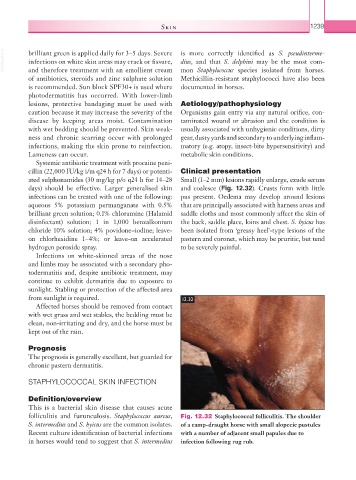Page 1264 - Equine Clinical Medicine, Surgery and Reproduction, 2nd Edition
P. 1264
Skin 1239
VetBooks.ir brilliant green is applied daily for 3–5 days. Severe is more correctly identified as S. pseudinterme-
dius, and that S. delphini may be the most com-
infections on white skin areas may crack or fissure,
and therefore treatment with an emollient cream
Methicillin-resistant staphylococci have also been
of antibiotics, steroids and zinc sulphate solution mon Staphylococcus species isolated from horses.
is recommended. Sun block SPF30+ is used where documented in horses.
photodermatitis has occurred. With lower-limb
lesions, protective bandaging must be used with Aetiology/pathophysiology
caution because it may increase the severity of the Organisms gain entry via any natural orifice, con-
disease by keeping areas moist. Contamination taminated wound or abrasion and the condition is
with wet bedding should be prevented. Skin weak- usually associated with unhygienic conditions, dirty
ness and chronic scarring occur with prolonged gear, dusty yards and secondary to underlying inflam-
infections, making the skin prone to reinfection. matory (e.g. atopy, insect-bite hypersensitivity) and
Lameness can occur. metabolic skin conditions.
Systemic antibiotic treatment with procaine peni-
cillin (22,000 IU/kg i/m q24 h for 7 days) or potenti- Clinical presentation
ated sulphonamides (30 mg/kg p/o q24 h for 14–28 Small (1–2 mm) lesions rapidly enlarge, exude serum
days) should be effective. Larger generalised skin and coalesce (Fig. 12.32). Crusts form with little
infections can be treated with one of the following: pus present. Oedema may develop around lesions
aqueous 5% potassium permanganate with 0.5% that are principally associated with harness areas and
brilliant green solution; 0.1% chloramine (Halamid saddle cloths and most commonly affect the skin of
disinfectant) solution; 1 in 1,000 benzalkonium the back, saddle place, loins and chest. S. hyicus has
chloride 10% solution; 4% povidone–iodine; leave- been isolated from ‘greasy heel’-type lesions of the
on chlorhexidine 1–4%; or leave-on accelerated pastern and coronet, which may be pruritic, but tend
hydrogen peroxide spray. to be severely painful.
Infections on white-skinned areas of the nose
and limbs may be associated with a secondary pho-
todermatitis and, despite antibiotic treatment, may
continue to exhibit dermatitis due to exposure to
sunlight. Stabling or protection of the affected area
from sunlight is required. 12.32
Affected horses should be removed from contact
with wet grass and wet stables, the bedding must be
clean, non-irritating and dry, and the horse must be
kept out of the rain.
Prognosis
The prognosis is generally excellent, but guarded for
chronic pastern dermatitis.
STAPHYLOCOCCAL SKIN INFECTION
Definition/overview
This is a bacterial skin disease that causes acute
folliculitis and furunculosis. Staphylococcus aureus, Fig. 12.32 Staphylococcal folliculitis. The shoulder
S. intermedius and S. hyicus are the common isolates. of a camp-draught horse with small alopecic pustules
Recent culture identification of bacterial infections with a number of adjacent small papules due to
in horses would tend to suggest that S. intermedius infection following rug rub.

